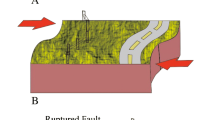Abstract
Engineering facilities subjected to natural hazards (such as winds and earthquakes) will result in risk when any designed system (i.e. capacity) will not be able to meet the performance required (i.e. demand). Risk might be expressed either as a likelihood of damage or potential financial loss. Engineers tend to make use of the former (i.e. damage). Nevertheless, other non-technical stakeholders cannot get useful information from damage. However, if financial risk is expressed on the basis of probable monetary loss, it will be easily understood by all. Therefore, it is necessary to develop methodologies which communicate the system capacity and demand to financial risk. Incremental dynamic analysis (IDA) was applied in a performance-based earthquake engineering context to do hazard analysis, structural analysis, damage analysis and loss analysis of a reinforced concrete (RC) frame structure. And the financial implications of risk were expressed by expected annual loss (EAL). The quantitative risk analysis proposed is applicable to any engineering facilities and any natural hazards. It is shown that the results from the IDA can be used to assess the overall financial risk exposure to earthquake hazard for a given constructed facility. The computational IDA-EAL method will enable engineers to take into account the long-term financial implications in addition to the construction cost. Consequently, it will help stakeholders make decisions.
Similar content being viewed by others
References
CORNELL C A, JALAYER F, HAMBURGER R O. Probabilistic basis for 2000 SAC federal emergency management agency steel moment frame guidelines[J]. Journal of Structural Engineering, 2002, 128(4): 526–533.
KRAWINKLER H, MIRANDA E. Performance-based earthquake engineering in earthquake engineering: From engineering seismology to performance-based engineering [M]. Boca Raton: CRC Press, 2004.
AUGUSTI G, CIAMPOLI M. Performance-based design in risk assessment and reduction [J]. Probabilistic Engineering Mechanics, 2008, 23(4): 496–508.
BRADLEY B A, CUBRINOVSKI M, DHAKAL R P, MACRAE G A. Probabilistic seismic performance and loss assessment of a bridge-foundation-soil system [J]. Soil Dynamics and Earthquake Engineering, 2010, 30(5): 395–411.
ASLANI H, MIRANDA E. Probability-based seismic response analysis [J]. Engineering Structures, 2005, 279(8): 1151–1163.
BAKER J W. Probabilistic structural response assessment using vector-valued intensity measures [J]. Earthquake Engineering and Structural Dynamics, 2007, 36: 1861–1883.
RUIZ G J. Performance-based assessment of existing structures accounting for residual displacements [D]. Stanford, California: Stanford University, 2004.
KRAWINKLER H. A general approach to seismic performance assessment [C]// Proc International Conference on Advances and New Challenges in Earthquake Engineering Research, ICANCEER. Hong Kong, 2002: 173–180.
DEIERLEIN G G, KRAWINKLER H, CORNELL C A. A framework for performance-based earthquake engineering [C]// Pacific Conference on Earthquake Engineering. Christchurch, New Zealand, 2003: 140.
BAKER J W, CORNELL C A. Vector-valued ground motion intensity measure consisting of spectral acceleration and epsilon [J]. Earthquake Engineering and Structural Dynamics, 2005, 34(10): 1193–1217.
TOTHONG P, LUCO N. Probabilistic seismic demand analysis using advanced ground motion intensity measures [J]. Earthquake Engineering and Structural Dynamics, 2007, 36(13): 1837–1860.
ALAVI B, KRAWINKLER H. Behavior of moment-resisting frame structures subjected to near-fault ground motions [J]. Earthquake Engineering and Structural Dynamics, 2004, 33(6): 687–706.
LUCO N, CORNELL C A. Structure-specific scalar intensity measures for near-source and ordinary earthquake ground motions [J]. Earthquake Spectral, 2007, 23(2): 357–392.
BAKER J W, CORNELL C A. Vector-valued intensity measures for pulse-like near-fault ground motions [J]. Engineering Structures, 2008, 30: 1048–1057.
DHAKAL R P, MANDER J B. Financial risk assessment methodology for natural hazards [J]. Bulletin of the New Zealand Society of Earthquake Engineering, 2006, 39(2): 91–105.
JGJ 3-2002, Technical specification for concrete structures of tall building [S].
GB 50011-2001, Code for seismic design of buildings [S].
VAMVATSIKOS D, CORNELL C A. Developing efficient scalar and vector intensity measures for IDA capacity estimation by incorporating elastic spectral shape information [J]. Earthquake Engineering and Structural Dynamics, 2005, 34(13): 1573–1600.
ERBERIK M A, ELNASHAI A S. Fragility analysis of flat-slab structures [J]. Engineering Structures, 2004, 26: 937–948.
VAMVATSIKOS D, CORNELL C A. Incremental dynamic analysis [J]. Earthquake Engineering and Structural Dynamics, 2002, 31: 491–514.
SHOME N, CORNELL C A, BAZZURRO P, CARBALLO J E. Earthquakes, records, and nonlinear responses [J]. Earthquake Spectra, 1998, 14(3): 469–500.
OPENSEES. Open system for earthquake engineering simulation [EB/OL]. 2009, http://opensees.berkeley.edu.
MANDER J B, DHAKAL R P, MASHIKO N, SOLBERG K M. Incremental dynamic analysis applied to seismic financial risk assessment of bridges [J]. Engineering Structures, 2007, 29: 2662–2672.
MARTINEZ M E. Performance-based seismic design and probabilistic assessment of reinforced concrete moment resisting frame structures [D]. New Zealand: Department of Civil Engineering, University of Canterbury, 2002.
ZAREIAN F, KRAWINKLER H. Assessment of probability of collapse and design for collapse safety [J]. Earthquake Engineering and Structural Dynamics, 2007, 36(13): 1901–1914.
KENNEDY R P, CORNELL C A, CAMPBELL R D, KAPLAN S, PERLA H F. Probabilistic seismic safety study of an existing nuclear power plant [J]. Nuclear Engineering and Design, 1980, 59(2): 315–338.
Federal emergency management agency (FEMA). Recommended seismic design criteria for new steel moment-frame buildings [R]. Rep. No. FEMA-350. Washington (DC): SAC Joint Venture, 2000.
Author information
Authors and Affiliations
Corresponding author
Additional information
Foundation item: Project(2011CB013804) supported by the National Basic Research Program of China; Project(50925828) supported by the National Natural Science Funds for Distinguished Young Scholars of China
Rights and permissions
About this article
Cite this article
Wu, Qy., Zhu, Hp. & Fan, J. Performance-based seismic financial risk assessment of reinforced concrete frame structures. J. Cent. South Univ. Technol. 19, 1425–1436 (2012). https://doi.org/10.1007/s11771-012-1159-2
Received:
Accepted:
Published:
Issue Date:
DOI: https://doi.org/10.1007/s11771-012-1159-2




